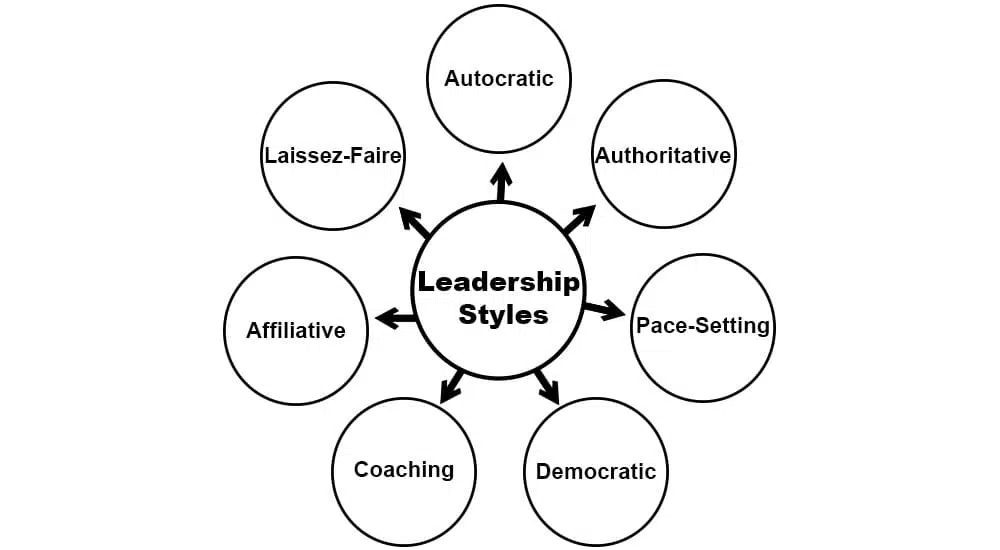Definition: A leadership style is a method of managing, directing, and motivating followers.
Leadership styles define how leaders strategize their relationships with their followers. Therefore, knowing the leadership style is vital to gaining followers’ loyalty and increasing the leader’s effectiveness.
This article overviews seven leadership styles, their pros and cons, factors affecting leadership styles, and tips on choosing the right leadership style.
Factors Affecting Leadership Styles
Leadership is about building relationships. A leader must ensure that the goal of the leadership style does not confine getting results. It must encourage a healthy relationship between leaders and followers.
Four factors affect leadership styles. These factors are:
- The Led
- The Leader
- The Situation
- The Communication
A leader must weigh these factors while selecting a leadership style because a key factor in one situation may not significantly affect another.
It is vital to understand these factors.
The Led
This is the team directly under a leader’s influence. They are the team members that the leader is responsible for.
The team has a common goal and must work together to achieve the goal.
A team comprises diverse members who respond differently to the same leadership style.
Leaders need to know their team members individually, e.g., their characteristics, driving force, traits, etc. For example, they should know if a team member has low self-esteem, possesses a can-do attitude, or is scared of trying.
Knowing each team member helps a leader determine their strengths and weaknesses, and they can use the best leadership style to motivate team members individually.
The Leader
Another critical factor that affects leadership style is the leaders themselves. Leaders must understand themselves, as their personality affects their leadership. They should know their strengths and weaknesses.
Self-awareness is important for a good leader. Looking inwards and honestly assessing themselves, acknowledging weaknesses and shortcomings, and being willing to make changes and improvements are vital for good leadership.
Being aware of their personality can allow them to communicate better, assess the needs of team members, and build productive relationships.
Leaders can ask superiors and colleagues to evaluate them and provide feedback.
Good leaders accept feedback and learn from it.
The Situation
One cannot use a single leadership style in all situations. A style useful for one situation might not work in another.
A leader has to consider PET factors before deciding on the leadership strategy. PET stands for people, equipment, and time.
A leader must consider the level of competence, motivation, and commitment of team members to perform the task. Some team members may need close monitoring, while others may not require such supervision.
Timing is key in leadership. Taking action at the right time is necessary to get the desired results.
A good leader who adopts the wrong leadership style may re-analyze it and take corrective action instead of holding on to it.
The Communication
Communication is the exchange of information from one person to another. Effective communication occurs when one party passes the message to the other, and the other party understands it and provides feedback.
Open communication makes communication more effective and motivates the team.
Body language and physical actions also represent a form of communication. The action or inaction in situations sends a message to the team.
Correct communication with the right leadership is essential in earning trust, building confidence, and motivating team members. Saying the right thing can boost the team’s morale, even if it is criticism. Likewise, criticism done in the right way can motivate team members. st
Types of Leadership Styles

- Autocratic Leadership
- Authoritative Leadership
- Pace-Setting Leadership
- Democratic Leadership
- Coaching Style Leadership
- Affiliative Leadership
- Laissez-Faire Leadership
#1. Autocratic Leadership
Autocratic leadership is a command-and-control type of leadership. An autocratic leader likes total control of the team. The typical “do as you’re told” leader does not allow opportunities for input and suggestions, and the word “team” does not apply to them. It is a strictly leader-and-follower kind of relationship.
Autocratic leaders consider themselves the smartest. Therefore, they like to assert their authority to show off their knowledge, skills, or perceived superiority at every possible moment.
This leadership method is not ideal, but autocratic leadership is not all bad. This leadership style might be handy when a crucial business decision is necessary. The leader knows his experience and superiority are the edges over other team members to make decisions.
Although this leadership style can be efficient in decision-making, it can restrain innovation, collaboration, and other ideas.
#2. Authoritative Leadership
The authoritative style of leadership is one where leaders lead by example. To best describe this leadership style, it is the “follow me” type. Here, leaders not only give commands; they lead by example. They made a move and led the team.
Authoritative leaders see their goals and lead their teams via actions. However, they do not only point the team towards the goals; they explain the idea and dream behind the goals. This is why they are called visionary leaders.
The difference between autocratic and authoritative leaders is the latter’s ability to communicate intentions with followers, unlike the autocratic leader, who thinks they do not owe anyone an explanation.
This leadership style is helpful in difficult situations, as the leader ensures the team focuses on the goals.
#3. Pace-Setting Leadership
The pace-setter leads by setting a quick and fast pace and expecting team members to catch up. An energetic and driven type, this leader has a “follow me and keep up!” attitude.
The pace-setter leadership style drives quick results but quickly wears down team members. This approach puts team members under enormous pressure, and it is not healthy in the long run.
This leadership style yields quick results. However, it is not useful in the long run and can cause team burnout.
This does not mean that pace-setter leadership has no significance. This style is useful when running towards tight deadlines.
#4. Democratic Leadership
Democratic leadership is also known as participative leadership. It involves team members in key decision-making. Democratic leaders do not make decisions themselves. Instead, they welcome input from team members and make their final decisions based on collective feedback.
In democratic leadership, the leader asks, “What do you think?” This involvement makes team members feel valued, and they will be more dedicated to their tasks.
#5. Coaching Style Leadership
The coaching leadership style believes everyone has great potential and guides them to achieve the objectives. Here, leaders provide guidance and support and expect team members to develop and achieve their potential. The coaching leader aims to bring out the best in the team while providing feedback and constructive criticism on team performance and areas of improvement.
The coaching leader asks, “What could you try?” and they believe there is nothing a team cannot achieve with the right motivation and guidance.
The coaching leader encourages two-way collaboration and communication and helps improve team skills to perform optimally.
#6. Affiliative Leadership
This leadership style encourages cooperation and agreement within teams.
It is a “people come first” type of leadership. The affiliative leader places the utmost importance on team members. They recognize and reward the personal behaviors that aid in carrying out tasks. Therefore, team members are not only rewarded for completing a task but also for how they complete it.
This leadership style offers opportunities for diversity and builds trust within an organization.
#7. Laissez-Faire Leadership
Laissez-Faire is the opposite of the autocratic leader. Here, leaders give team members the full rein of responsibility. They allow team members to make decisions and do not interfere.
This leadership style encourages trust between team members and leaders. However, this method does not work well with unskilled and unmotivated workers.
The Laissez-Faire leadership style allows team members to take responsibility and make decisions. It is important to ensure this freedom does not backfire. This leadership style works well with skilled and experienced professionals who can work independently. However, the team leader needs to monitor team performance.
Choosing a Leadership Style
The following tips are beneficial for selecting the right leadership style:
- The leader must analyze their team. Knowing the team member’s strengths and weaknesses, experience, skills, maturity, and motivational level helps determine the right leadership strategy. Find what motivates them and how best they can work given different situations.
- Good communication is the key to building mutual trust and respect in a team. A good leader should not be unpredictable. Being consistent in dealing with team members encourages them to approach the leader honestly and openly.
- Team members have different strengths and weaknesses and require different levels of supervision. Therefore, a new team member cannot perform similarly to experienced team members.
- A leader should consider the situation, job, and team members while selecting the leadership style.
Can a Leader Change Leadership Style?
Yes, a leader can change their leadership depending on the phase of the team formation.
For example, if the team is in the storming phase, the leader can have an autocratic style of leadership because team members are new, not well aware of roles and responsibilities, and need firm direction from the leader.
However, when the team is in the performing stage, the leader can relax and follow the Laissez-Faire Leadership style.
Why Should You Know Your Leadership Style?
Every individual and a natural leadership style, and they are born with it. However, knowing your leadership style is important because, as a leader, you will have many followers, and your leadership style will influence your followers.
You can motivate or demotivate them depending on how you lead them.
If you are not aware of your leadership style, you can ask your followers and peers for feedback on your style of leadership.
Once you know your leadership, you can improve it to lead your team in the right direction.
Conclusion
Leadership must be effective. Leaders must know what leadership styles work best for different situations and select the right one. Great leaders choose the right strategy in all conditions. They analyze the team’s maturity and then select the appropriate leadership style.
The right leadership style creates the best opportunity to get followers behind leaders and offer their full potential to complete the project.

I am Mohammad Fahad Usmani, B.E. PMP, PMI-RMP. I have been blogging on project management topics since 2011. To date, thousands of professionals have passed the PMP exam using my resources.




